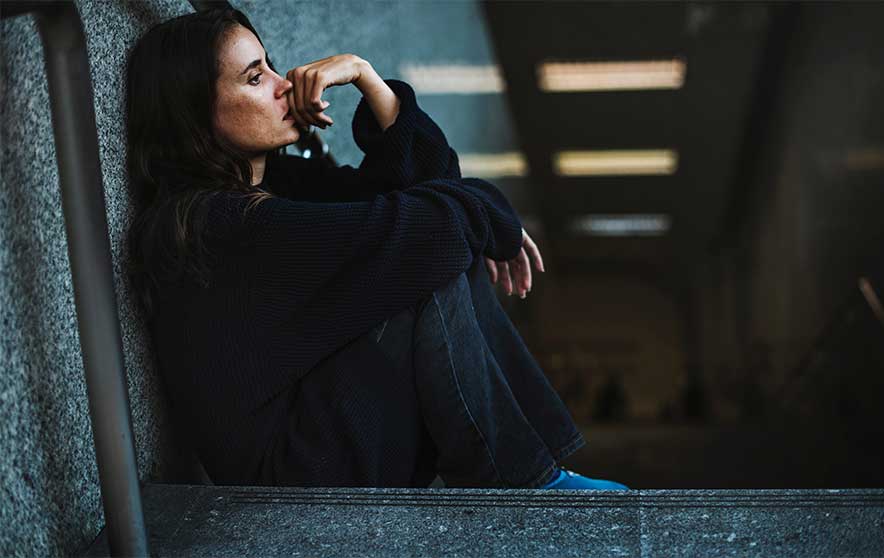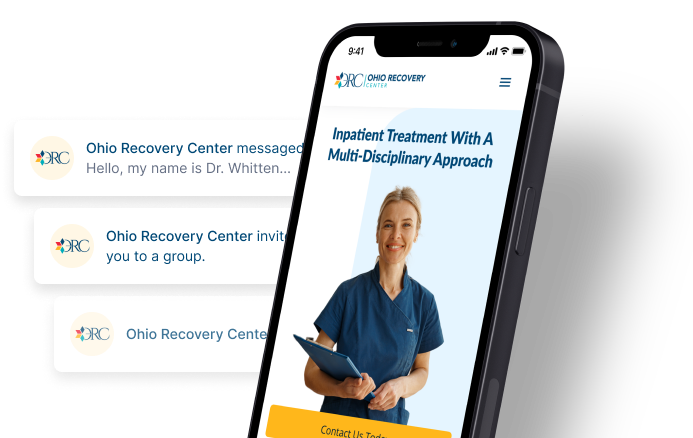Depression & Opioid Addiction | Prevalence, Symptoms, & Treatment

Medically Reviewed By: Manish Mishra, MBBS
Some people try to self-medicate symptoms of major depression with opioids, which pose a high risk of opioid use disorder (opioid addiction). People with co-occurring depression and opioid use disorder should seek help at a dual diagnosis treatment program.

According to the National Institute of Mental Health, about 21 million U.S. adults have experienced major depression, also known as major depressive disorder (MDD). This mental health condition causes overwhelming sadness or numbness.
Some people try to self-medicate their depression with opioids, which increases the risk of developing opioid use disorder (OUD).
How Common Is Co-Occurring Depression & Opioid Use Disorder?
According to the National Survey on Drug Use and Health, 64.3% of adults with OUD have a co-occurring mental health problem.
Studies suggest that the most common co-occurring disorder is major depression, which affects between 20% and 30% of people seeking OUD treatment. Also, the lifetime prevalence of co-occurring depression and OUD is as high as 60%.
Risk Factors
Most cases of co-occurring depression and OUD start with opioid misuse. Opioid misuse occurs when you use opioids in a way that harms your health. For example, you might use the illegal opioid heroin, or you might use prescription opioids in a manner not prescribed.
The most commonly misused prescription opioids include:
- oxycodone (OxyContin, Percocet)
- hydrocodone (Lortab, Vicodin)
- meperidine (Demerol)
- codeine
- morphine
Along with easing acute and chronic pain, opioids can also cause relaxation and euphoria (intense joy). That’s why some people use them to self-medicate depressive episodes. While misusing opioids may temporarily make you feel better, it poses a high risk of overdose and addiction.
You face an increased risk of co-occurring depression and opioid use disorder if you have a family history of either disease. Other risk factors include trauma, early drug use, and peer pressure.
Symptoms Of Co-Occurring Depression & Opioid Use Disorder
According to the Centers for Disease Control and Prevention (CDC), the most common symptoms of depression include:
- persistent sadness, emptiness, or hopelessness
- anxiety
- irritability
- guilt
- difficulty experiencing pleasure
- fatigue
- trouble sleeping or oversleeping
- changes in appetite or weight
- isolation
- physical aches or pains
- digestive issues
- cognitive impairments, such as poor memory, trouble concentrating, and reduced attention span
- suicidal ideation or suicide attempts
The most common symptoms of opioid use disorder include:
- frequent opioid cravings
- tolerance (needing increasingly larger or more frequent doses of opioids to feel the desired effects)
- physical dependence (experiencing withdrawal symptoms, such as anxiety and sweating, when you don’t use opioids)
- loss of motivation
- loss of interest in activities once enjoyed
- doctor shopping (visiting multiple doctors to get multiple opioid prescriptions)
- sudden financial issues
- decline in personal hygiene
- mood swings
- drowsiness
- frequent flu-like symptoms
When left untreated, opioid use disorder can make depression worse, and vice versa. In fact, according to public health researchers, this type of psychiatric comorbidity often leads to more severe mental health symptoms, reduced quality of life, and more emergency department visits.
Dual Diagnosis Treatment For Depression & OUD
If you or someone you love experiences the above symptoms, seek help at a dual diagnosis treatment program.
These substance abuse treatment programs also address psychiatric disorders, including anxiety disorders, post-traumatic stress disorder (PTSD), and mood disorders like bipolar disorder and depression.
Some dual diagnosis treatment programs are outpatient, meaning you live at home and regularly visit a treatment center. These programs typically work best for people with milder disorders and supportive home environments.
Other dual diagnosis treatment programs are inpatient, meaning you live at a treatment center and receive 24/7 care. These programs are recommended for people with moderate-to-severe disorders.
Whether outpatient or inpatient, dual diagnosis programs offer a variety of treatment options, including:
Medical Detox
Medical detox is usually the first phase of treatment for substance use disorder (SUD). During detox, doctors help you slowly and safely stop using opioids with minimal withdrawal symptoms. They may also prescribe medications to ease certain symptoms.
Therapy
In therapy, a behavioral health care provider will teach you how to recover from your depression and opioid dependence. You’ll learn important coping skills, such as journaling, exercising, and creative expression. Your therapist will also help you identify unhelpful beliefs or behaviors that might contribute to your depression and drug abuse.
Support Groups
When recovering from addiction and mental illness, you may feel misunderstood. In a support group, you can connect with people facing similar challenges. You can also learn about new coping strategies and treatment interventions that have helped your peers.
Medication
Medication-assisted treatment is an effective treatment option for both opioid use disorder and alcohol use disorder (also called alcohol dependence). Medications used to treat opioid use disorder include:
- methadone and buprenorphine, which ease opioid cravings and withdrawal symptoms
- Suboxone, which consists of buprenorphine and naloxone, a medication that can prevent opioid overdose deaths
- naltrexone, which discourages opioid and alcohol abuse by blocking the pleasant effects of these drugs
According to the Substance Abuse and Mental Health Services Administration (SAMHSA), all of these medications can greatly improve treatment outcomes for people with opioid use disorder.
Your treatment team may also prescribe antidepressants or anti-anxiety medications. These medications can boost your sense of well-being and help you engage more in therapy.
Aftercare Planning
Like other mental health disorders, addiction and depression come with a risk of relapse. To lower this risk, your doctors can help you create an aftercare plan. Depending on your needs, this plan may include strategies such as:
- ongoing therapy and psychiatry appointments
- wellness activities, such as yoga, meditation, and arts and crafts
- alternative depression treatments, such as transcranial magnetic stimulation (TMS)
- assistance with employment, education, or housing
To learn more about depression and addiction treatment, please reach out to Ohio Recovery Center. Our board-certified clinicians offer personalized, evidence-based care to help you or your loved one build a healthy life.
- Centers for Disease Control and Prevention https://www.cdc.gov/tobacco/campaign/tips/diseases/depression-anxiety.html
- Journal of Dual Diagnosis https://www.ncbi.nlm.nih.gov/pmc/articles/PMC10294295/
- National Institute of Mental Health https://www.nimh.nih.gov/health/statistics/major-depression
- National Library of Medicine: MedlinePlus https://medlineplus.gov/ency/article/000949.htm
- National Library of Medicine: MedlinePlus https://www.ncbi.nlm.nih.gov/books/NBK553166/

